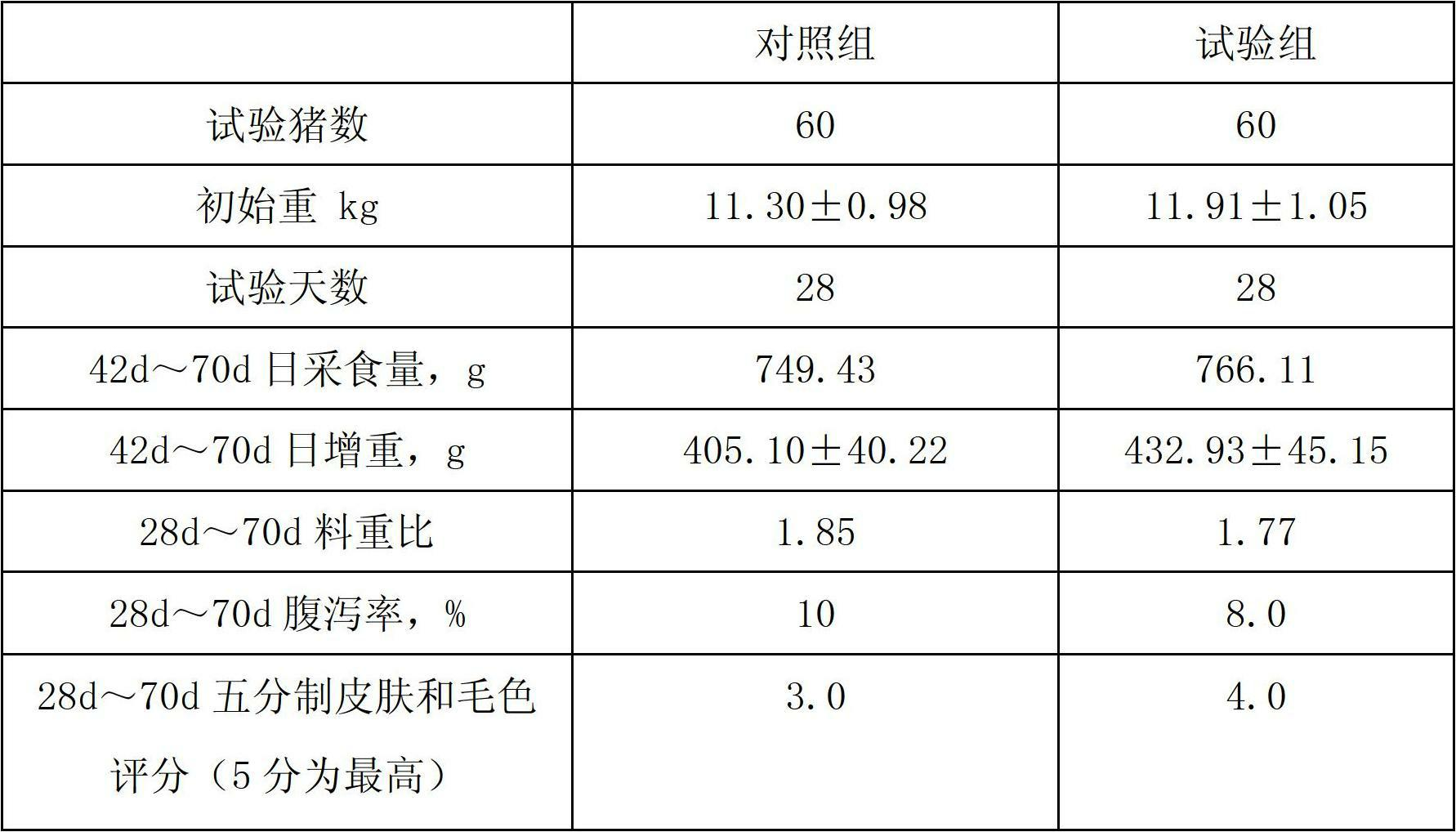Compound feed product for breastfeed suckling pigs
A technology for compound feed and suckling pigs, applied in the field of livestock feed, can solve the problems of reduced intestinal digestion and absorption efficiency, rough and unkempt coat, unfriendly environment, etc., to improve growth quality, resist diarrhea, and avoid piglet hair. long effect
- Summary
- Abstract
- Description
- Claims
- Application Information
AI Technical Summary
Problems solved by technology
Method used
Image
Examples
Embodiment 1
[0021] Embodiment 1 The compound feed for suckling piglets is composed as follows according to the ratio of parts by weight: unit: part
[0022] 55 parts of corn, 8 parts of flour, 4 parts of whey powder, 2.5 parts of fish meal, 2.5 parts of glucose, 7 parts of high-protein soybean meal, 0.013 parts of 5000 units of phytase, 0.45 parts of calcium hydrogen phosphate, 0.04 parts of choline chloride, Lai 0.3 part of amino acid, 0.07 part of methionine, 0.1 part of threonine, 0.04 part of tryptophan, 0.01 part of zinc sulfate, 0.011 part of ferrous sulfate, 0.004 part of iron glycinate, 0.004 part of manganese sulfate, 0.000022 part of sodium selenite, yeast 0.00002 parts of selenium, 0.08 parts of nicotinic acid; 0.009 parts of copper sulfate, 0.009 parts of basic copper chloride;
[0023] Also add vitamin A acetate and vitamin D3 acetate in the above-mentioned feed, add vitamin A acetate 12000 international units per kilogram of feed, add vitamin D3 acetate 3000 international un...
Embodiment 2
[0039] 50 parts of corn, 10 parts of flour, 3 parts of whey powder, 3 parts of fish meal, 2 parts of glucose, 8 parts of high-protein soybean meal, 0.012 parts of 5000 units of phytase, 0.5 parts of calcium hydrogen phosphate, 0.05 parts of choline chloride, Lai 0.2 parts of amino acid, 0.10 parts of methionine, 0.05 parts of threonine, 0.05 parts of tryptophan, 0.009 parts of zinc sulfate, 0.013 parts of ferrous sulfate, 0.004 parts of iron glycinate, 0.005 parts of manganese sulfate, 0.000020 parts of sodium selenite, yeast 0.00002 parts of selenium, 0.06 parts of nicotinic acid; 0.01 parts of copper sulfate, 0.008 parts of basic copper chloride;
[0040] Also add vitamin A acetate and vitamin D3 acetate in the above-mentioned feed, add 15000 international units of vitamin A acetate per kilogram of feed, add 2500 international units of vitamin D3 acetate in every kilogram of feed.
[0041] The protein content of the high-protein soybean meal is 46%;
Embodiment 3
[0043] 60 parts of corn, 5 parts of flour, 5 parts of whey powder, 2 parts of fish meal, 3 parts of glucose, 5 parts of high-protein soybean meal, 0.015 parts of 5000 units of phytase, 0.4 parts of calcium hydrogen phosphate, 0.03 parts of choline chloride, adding Amino acids include 0.4 parts of lysine, 0.05 parts of methionine, 0.15 parts of threonine, 0.02 parts of tryptophan, 0.012 parts of zinc sulfate, 0.01 parts of ferrous sulfate, 0.005 parts of iron glycinate, 0.0033 parts of manganese sulfate, and 0.000025 parts of sodium selenite 0.00002 parts of yeast selenium, 0.09 parts of nicotinic acid; 0.008 parts of copper sulfate, 0.01 parts of basic copper chloride;
[0044] Also add vitamin A acetate and vitamin D acetate in the above-mentioned feed, add vitamin A acetate 13000 international units in the feed of every kilograms, add vitamin D acetate 28 international units in the feed of every kilograms.
[0045]The protein content of the high-protein soybean meal is 46%.
PUM
 Login to View More
Login to View More Abstract
Description
Claims
Application Information
 Login to View More
Login to View More - R&D
- Intellectual Property
- Life Sciences
- Materials
- Tech Scout
- Unparalleled Data Quality
- Higher Quality Content
- 60% Fewer Hallucinations
Browse by: Latest US Patents, China's latest patents, Technical Efficacy Thesaurus, Application Domain, Technology Topic, Popular Technical Reports.
© 2025 PatSnap. All rights reserved.Legal|Privacy policy|Modern Slavery Act Transparency Statement|Sitemap|About US| Contact US: help@patsnap.com

